Analysis and Modeling of Engineering Systems: Task 2, 3, and 4
VerifiedAdded on 2023/01/19
|15
|2415
|43
Homework Assignment
AI Summary
This assignment presents solutions to various engineering problems, encompassing determinant calculations, Gaussian elimination, and inverse matrix methods. It delves into circuit analysis, including capacitor voltage calculations, and explores mathematical modeling using differential equations. The document also covers the bisection and Newton's methods for solving equations, alongside the application of Laplace transforms to differential equations. Furthermore, it addresses LCR series circuits and first-order RC circuits, providing comprehensive solutions and analysis for each task. The assignment encompasses a wide range of engineering concepts, offering a thorough understanding of system analysis and modeling techniques.
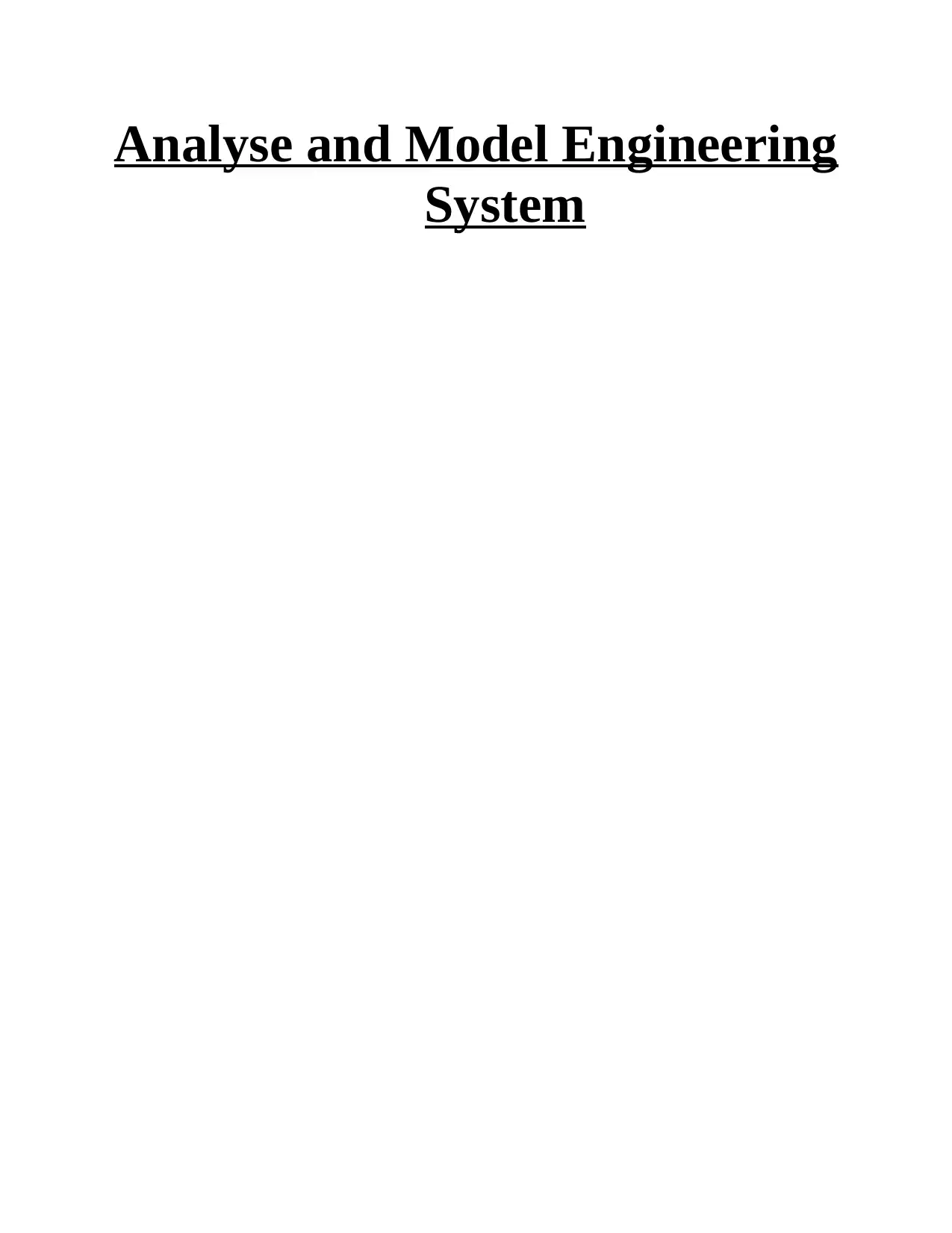
Analyse and Model Engineering
System
System
Paraphrase This Document
Need a fresh take? Get an instant paraphrase of this document with our AI Paraphraser

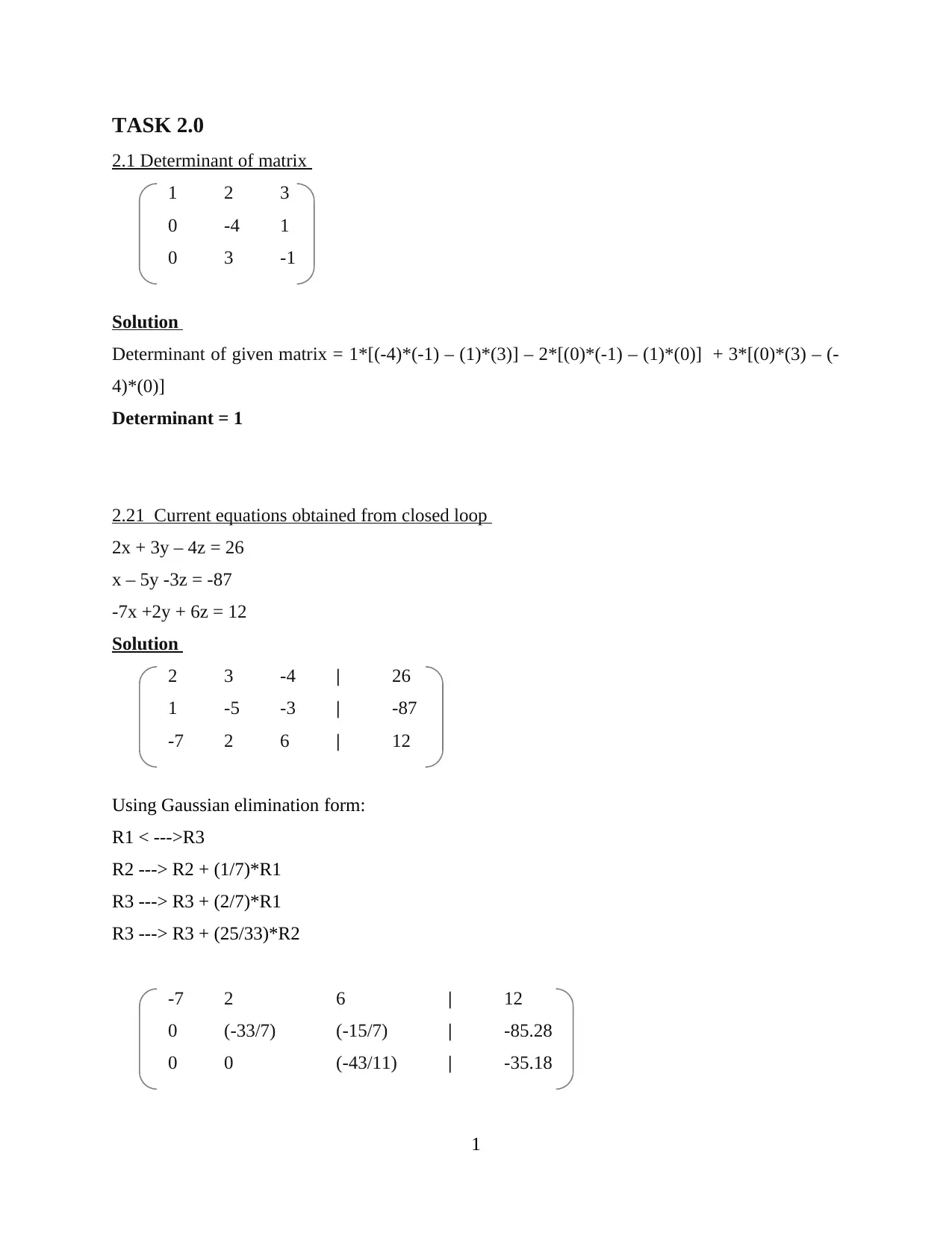
TASK 2.0
2.1 Determinant of matrix
1 2 3
0 -4 1
0 3 -1
Solution
Determinant of given matrix = 1*[(-4)*(-1) – (1)*(3)] – 2*[(0)*(-1) – (1)*(0)] + 3*[(0)*(3) – (-
4)*(0)]
Determinant = 1
2.21 Current equations obtained from closed loop
2x + 3y – 4z = 26
x – 5y -3z = -87
-7x +2y + 6z = 12
Solution
2 3 -4 | 26
1 -5 -3 | -87
-7 2 6 | 12
Using Gaussian elimination form:
R1 < --->R3
R2 ---> R2 + (1/7)*R1
R3 ---> R3 + (2/7)*R1
R3 ---> R3 + (25/33)*R2
-7 2 6 | 12
0 (-33/7) (-15/7) | -85.28
0 0 (-43/11) | -35.18
1
2.1 Determinant of matrix
1 2 3
0 -4 1
0 3 -1
Solution
Determinant of given matrix = 1*[(-4)*(-1) – (1)*(3)] – 2*[(0)*(-1) – (1)*(0)] + 3*[(0)*(3) – (-
4)*(0)]
Determinant = 1
2.21 Current equations obtained from closed loop
2x + 3y – 4z = 26
x – 5y -3z = -87
-7x +2y + 6z = 12
Solution
2 3 -4 | 26
1 -5 -3 | -87
-7 2 6 | 12
Using Gaussian elimination form:
R1 < --->R3
R2 ---> R2 + (1/7)*R1
R3 ---> R3 + (2/7)*R1
R3 ---> R3 + (25/33)*R2
-7 2 6 | 12
0 (-33/7) (-15/7) | -85.28
0 0 (-43/11) | -35.18
1
⊘ This is a preview!⊘
Do you want full access?
Subscribe today to unlock all pages.

Trusted by 1+ million students worldwide
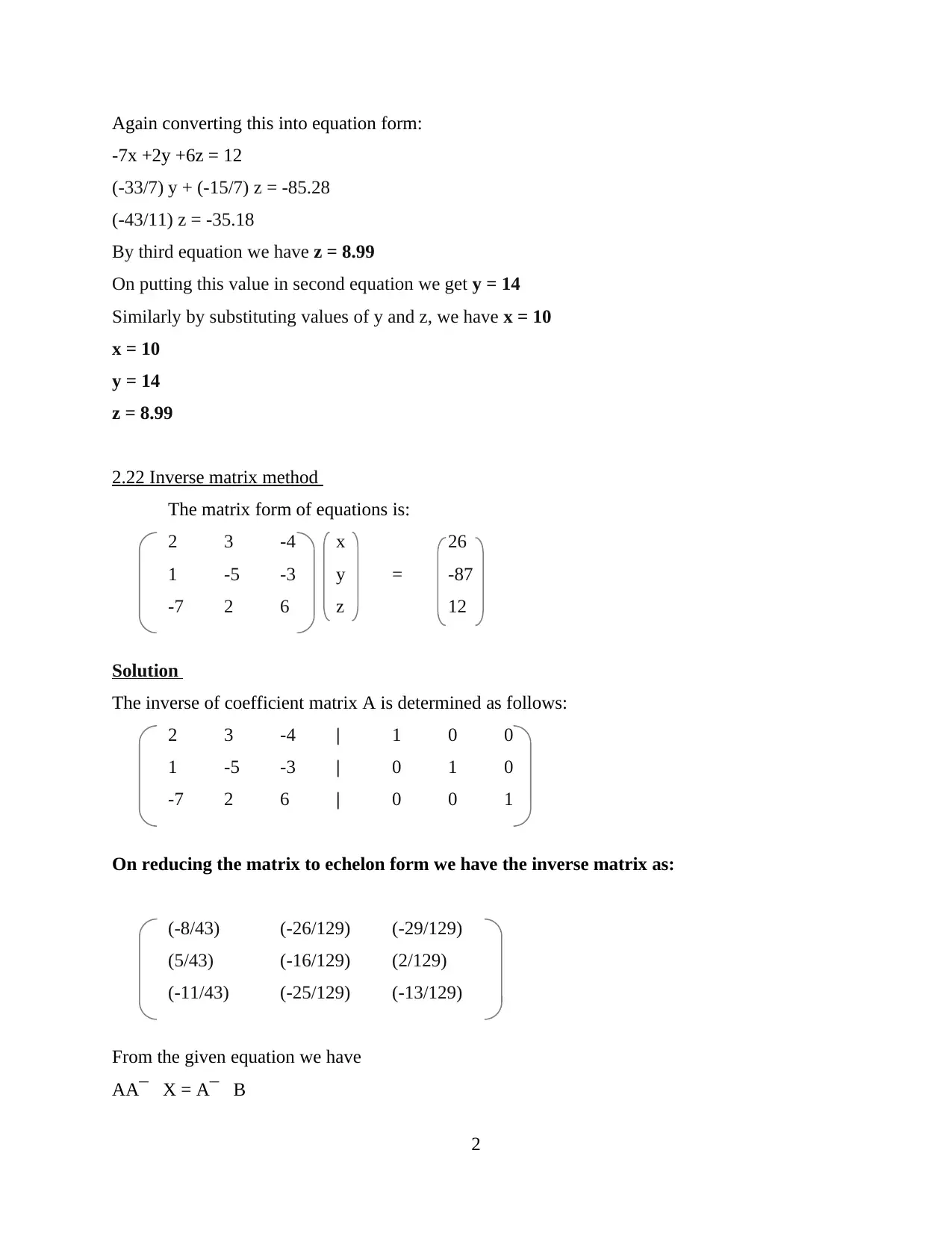
Again converting this into equation form:
-7x +2y +6z = 12
(-33/7) y + (-15/7) z = -85.28
(-43/11) z = -35.18
By third equation we have z = 8.99
On putting this value in second equation we get y = 14
Similarly by substituting values of y and z, we have x = 10
x = 10
y = 14
z = 8.99
2.22 Inverse matrix method
The matrix form of equations is:
2 3 -4 x 26
1 -5 -3 y = -87
-7 2 6 z 12
Solution
The inverse of coefficient matrix A is determined as follows:
2 3 -4 | 1 0 0
1 -5 -3 | 0 1 0
-7 2 6 | 0 0 1
On reducing the matrix to echelon form we have the inverse matrix as:
(-8/43) (-26/129) (-29/129)
(5/43) (-16/129) (2/129)
(-11/43) (-25/129) (-13/129)
From the given equation we have
AA¯X = A¯B
2
-7x +2y +6z = 12
(-33/7) y + (-15/7) z = -85.28
(-43/11) z = -35.18
By third equation we have z = 8.99
On putting this value in second equation we get y = 14
Similarly by substituting values of y and z, we have x = 10
x = 10
y = 14
z = 8.99
2.22 Inverse matrix method
The matrix form of equations is:
2 3 -4 x 26
1 -5 -3 y = -87
-7 2 6 z 12
Solution
The inverse of coefficient matrix A is determined as follows:
2 3 -4 | 1 0 0
1 -5 -3 | 0 1 0
-7 2 6 | 0 0 1
On reducing the matrix to echelon form we have the inverse matrix as:
(-8/43) (-26/129) (-29/129)
(5/43) (-16/129) (2/129)
(-11/43) (-25/129) (-13/129)
From the given equation we have
AA¯X = A¯B
2
Paraphrase This Document
Need a fresh take? Get an instant paraphrase of this document with our AI Paraphraser
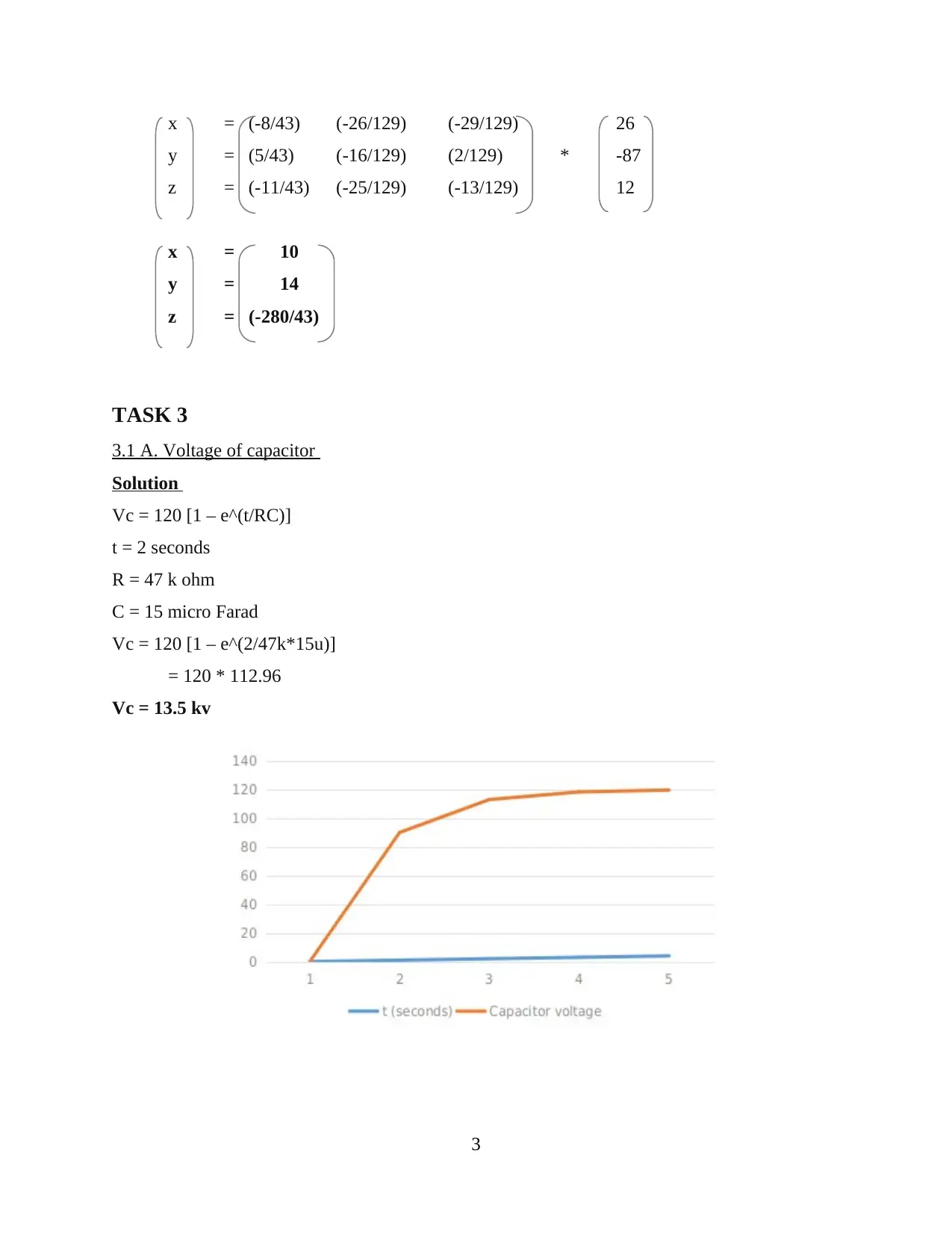
x = (-8/43) (-26/129) (-29/129) 26
y = (5/43) (-16/129) (2/129) * -87
z = (-11/43) (-25/129) (-13/129) 12
x = 10
y = 14
z = (-280/43)
TASK 3
3.1 A. Voltage of capacitor
Solution
Vc = 120 [1 – e^(t/RC)]
t = 2 seconds
R = 47 k ohm
C = 15 micro Farad
Vc = 120 [1 – e^(2/47k*15u)]
= 120 * 112.96
Vc = 13.5 kv
3
y = (5/43) (-16/129) (2/129) * -87
z = (-11/43) (-25/129) (-13/129) 12
x = 10
y = 14
z = (-280/43)
TASK 3
3.1 A. Voltage of capacitor
Solution
Vc = 120 [1 – e^(t/RC)]
t = 2 seconds
R = 47 k ohm
C = 15 micro Farad
Vc = 120 [1 – e^(2/47k*15u)]
= 120 * 112.96
Vc = 13.5 kv
3
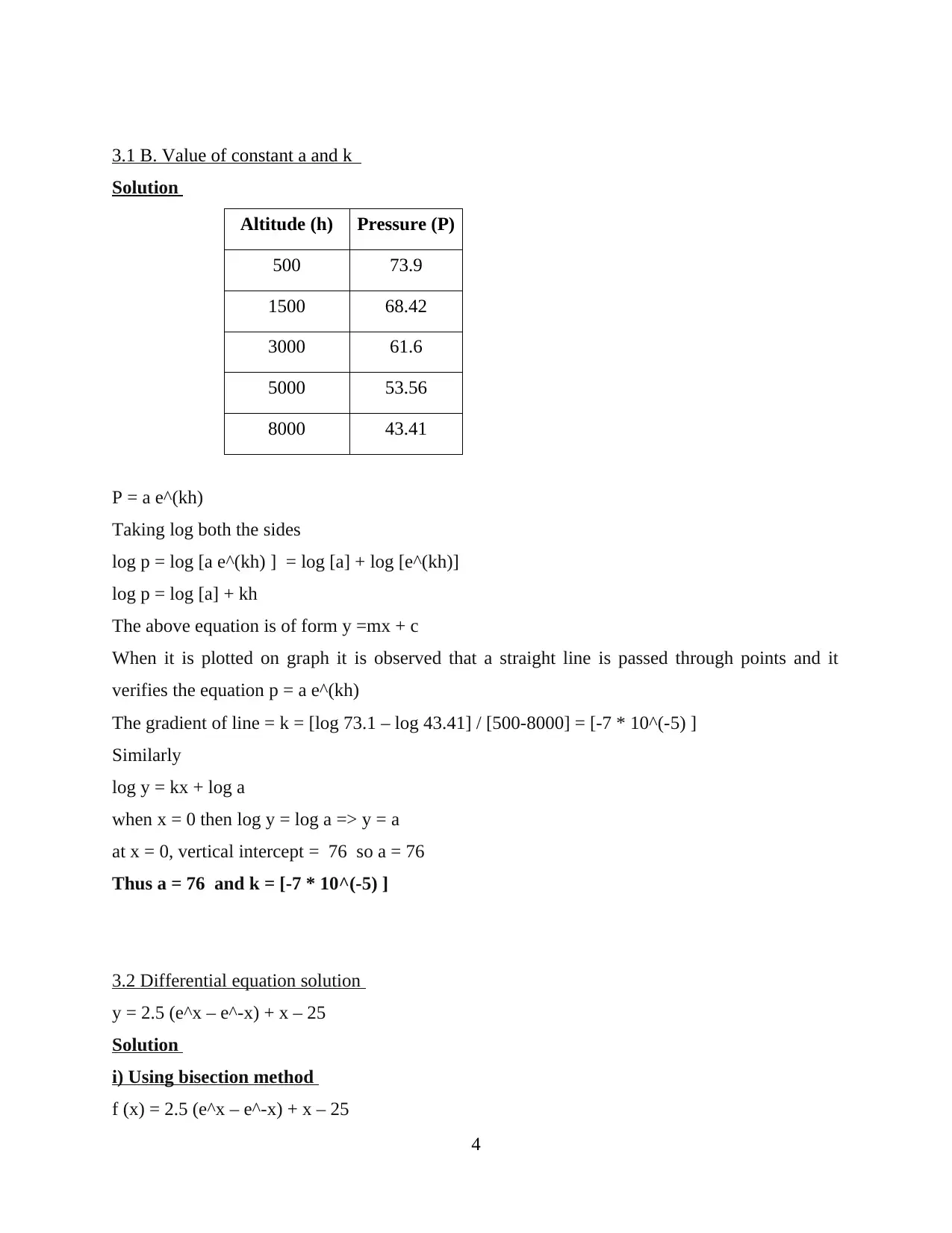
3.1 B. Value of constant a and k
Solution
Altitude (h) Pressure (P)
500 73.9
1500 68.42
3000 61.6
5000 53.56
8000 43.41
P = a e^(kh)
Taking log both the sides
log p = log [a e^(kh) ] = log [a] + log [e^(kh)]
log p = log [a] + kh
The above equation is of form y =mx + c
When it is plotted on graph it is observed that a straight line is passed through points and it
verifies the equation p = a e^(kh)
The gradient of line = k = [log 73.1 – log 43.41] / [500-8000] = [-7 * 10^(-5) ]
Similarly
log y = kx + log a
when x = 0 then log y = log a => y = a
at x = 0, vertical intercept = 76 so a = 76
Thus a = 76 and k = [-7 * 10^(-5) ]
3.2 Differential equation solution
y = 2.5 (e^x – e^-x) + x – 25
Solution
i) Using bisection method
f (x) = 2.5 (e^x – e^-x) + x – 25
4
Solution
Altitude (h) Pressure (P)
500 73.9
1500 68.42
3000 61.6
5000 53.56
8000 43.41
P = a e^(kh)
Taking log both the sides
log p = log [a e^(kh) ] = log [a] + log [e^(kh)]
log p = log [a] + kh
The above equation is of form y =mx + c
When it is plotted on graph it is observed that a straight line is passed through points and it
verifies the equation p = a e^(kh)
The gradient of line = k = [log 73.1 – log 43.41] / [500-8000] = [-7 * 10^(-5) ]
Similarly
log y = kx + log a
when x = 0 then log y = log a => y = a
at x = 0, vertical intercept = 76 so a = 76
Thus a = 76 and k = [-7 * 10^(-5) ]
3.2 Differential equation solution
y = 2.5 (e^x – e^-x) + x – 25
Solution
i) Using bisection method
f (x) = 2.5 (e^x – e^-x) + x – 25
4
⊘ This is a preview!⊘
Do you want full access?
Subscribe today to unlock all pages.

Trusted by 1+ million students worldwide
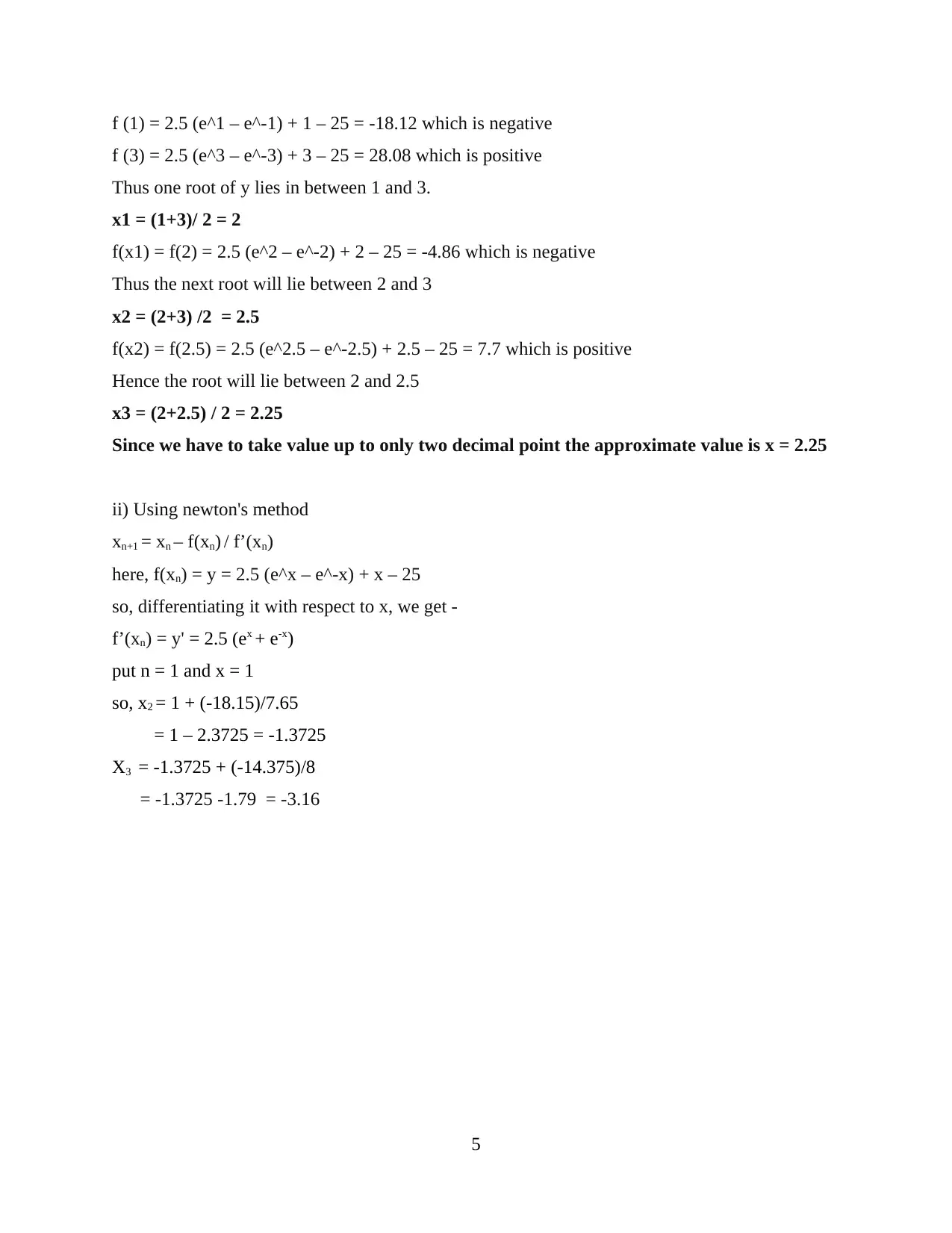
f (1) = 2.5 (e^1 – e^-1) + 1 – 25 = -18.12 which is negative
f (3) = 2.5 (e^3 – e^-3) + 3 – 25 = 28.08 which is positive
Thus one root of y lies in between 1 and 3.
x1 = (1+3)/ 2 = 2
f(x1) = f(2) = 2.5 (e^2 – e^-2) + 2 – 25 = -4.86 which is negative
Thus the next root will lie between 2 and 3
x2 = (2+3) /2 = 2.5
f(x2) = f(2.5) = 2.5 (e^2.5 – e^-2.5) + 2.5 – 25 = 7.7 which is positive
Hence the root will lie between 2 and 2.5
x3 = (2+2.5) / 2 = 2.25
Since we have to take value up to only two decimal point the approximate value is x = 2.25
ii) Using newton's method
xn+1 = xn – f(xn) / f’(xn)
here, f(xn) = y = 2.5 (e^x – e^-x) + x – 25
so, differentiating it with respect to x, we get -
f’(xn) = y' = 2.5 (ex + e-x)
put n = 1 and x = 1
so, x2 = 1 + (-18.15)/7.65
= 1 – 2.3725 = -1.3725
X3 = -1.3725 + (-14.375)/8
= -1.3725 -1.79 = -3.16
5
f (3) = 2.5 (e^3 – e^-3) + 3 – 25 = 28.08 which is positive
Thus one root of y lies in between 1 and 3.
x1 = (1+3)/ 2 = 2
f(x1) = f(2) = 2.5 (e^2 – e^-2) + 2 – 25 = -4.86 which is negative
Thus the next root will lie between 2 and 3
x2 = (2+3) /2 = 2.5
f(x2) = f(2.5) = 2.5 (e^2.5 – e^-2.5) + 2.5 – 25 = 7.7 which is positive
Hence the root will lie between 2 and 2.5
x3 = (2+2.5) / 2 = 2.25
Since we have to take value up to only two decimal point the approximate value is x = 2.25
ii) Using newton's method
xn+1 = xn – f(xn) / f’(xn)
here, f(xn) = y = 2.5 (e^x – e^-x) + x – 25
so, differentiating it with respect to x, we get -
f’(xn) = y' = 2.5 (ex + e-x)
put n = 1 and x = 1
so, x2 = 1 + (-18.15)/7.65
= 1 – 2.3725 = -1.3725
X3 = -1.3725 + (-14.375)/8
= -1.3725 -1.79 = -3.16
5
Paraphrase This Document
Need a fresh take? Get an instant paraphrase of this document with our AI Paraphraser
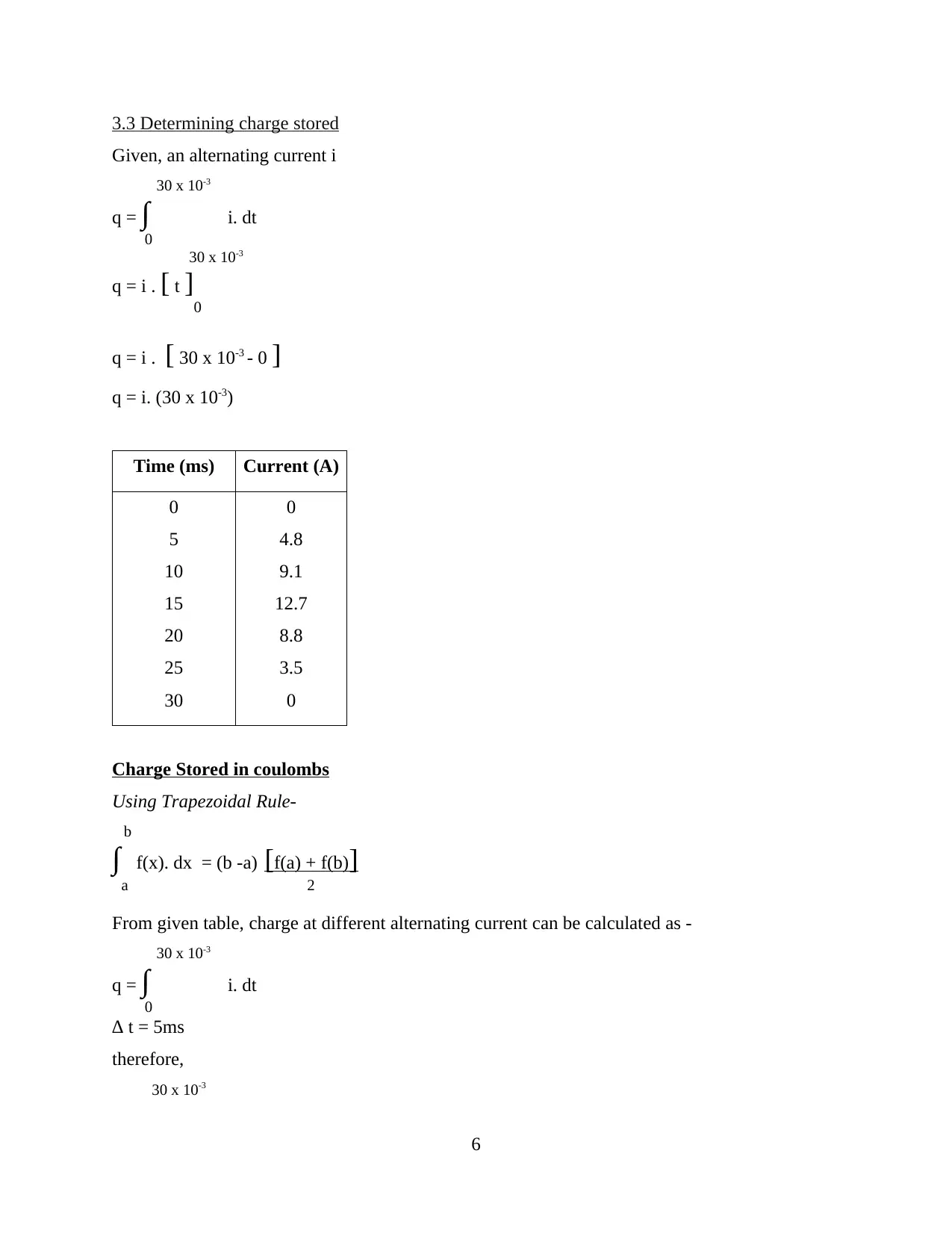
3.3 Determining charge stored
Given, an alternating current i
30 x 10-3
q = ∫ i. dt
0
30 x 10-3
q = i . [ t ]0
q = i . [ 30 x 10-3 - 0 ]
q = i. (30 x 10-3)
Time (ms) Current (A)
0
5
10
15
20
25
30
0
4.8
9.1
12.7
8.8
3.5
0
Charge Stored in coulombs
Using Trapezoidal Rule-
b
∫ f(x). dx = (b -a) [f(a) + f(b)]
a 2
From given table, charge at different alternating current can be calculated as -
30 x 10-3
q = ∫ i. dt
0
∆ t = 5ms
therefore,
30 x 10-3
6
Given, an alternating current i
30 x 10-3
q = ∫ i. dt
0
30 x 10-3
q = i . [ t ]0
q = i . [ 30 x 10-3 - 0 ]
q = i. (30 x 10-3)
Time (ms) Current (A)
0
5
10
15
20
25
30
0
4.8
9.1
12.7
8.8
3.5
0
Charge Stored in coulombs
Using Trapezoidal Rule-
b
∫ f(x). dx = (b -a) [f(a) + f(b)]
a 2
From given table, charge at different alternating current can be calculated as -
30 x 10-3
q = ∫ i. dt
0
∆ t = 5ms
therefore,
30 x 10-3
6
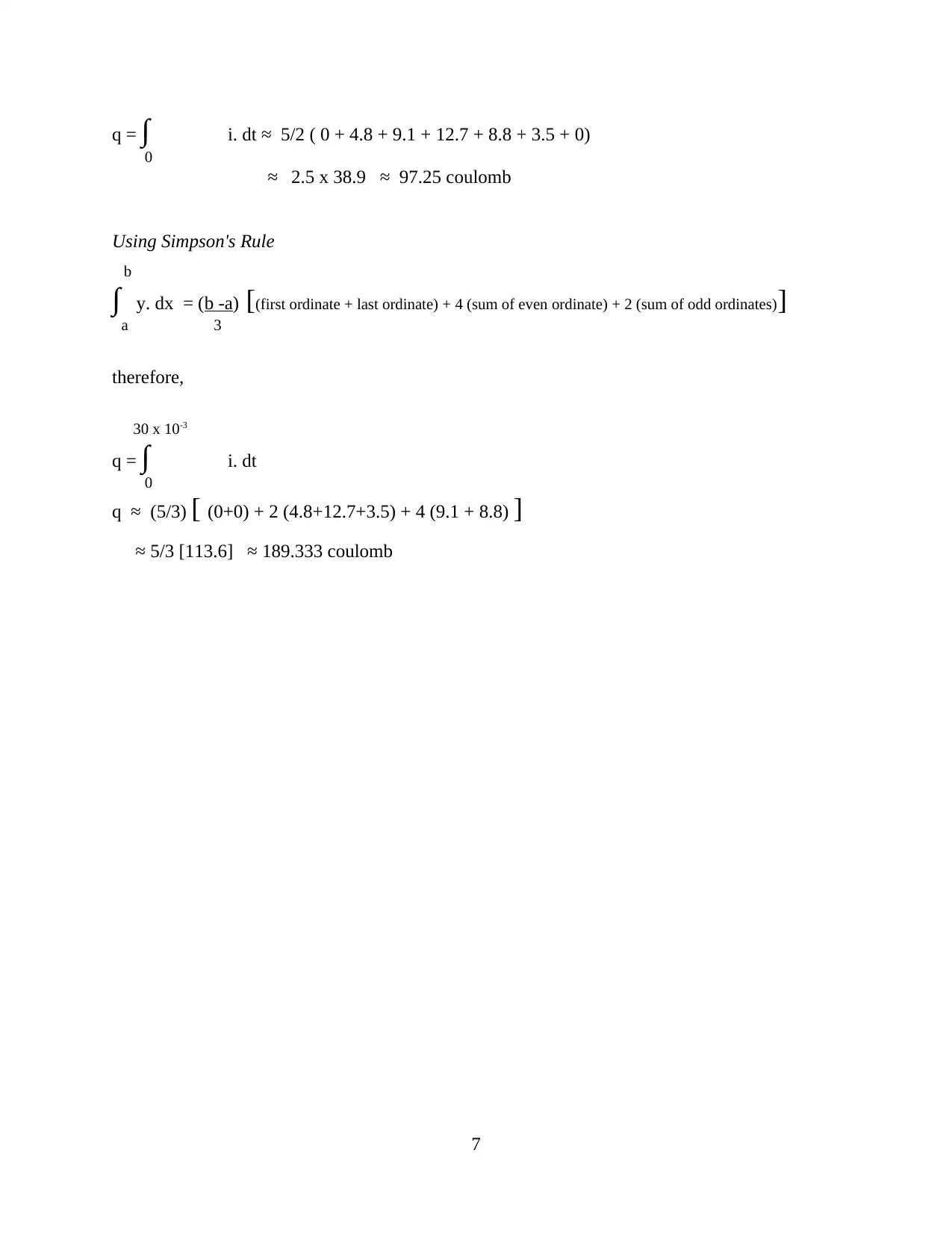
q = ∫ i. dt ≈ 5/2 ( 0 + 4.8 + 9.1 + 12.7 + 8.8 + 3.5 + 0)
0
≈ 2.5 x 38.9 ≈ 97.25 coulomb
Using Simpson's Rule
b
∫ y. dx = (b -a) [(first ordinate + last ordinate) + 4 (sum of even ordinate) + 2 (sum of odd ordinates)]
a 3
therefore,
30 x 10-3
q = ∫ i. dt
0
q ≈ (5/3) [ (0+0) + 2 (4.8+12.7+3.5) + 4 (9.1 + 8.8) ]
≈ 5/3 [113.6] ≈ 189.333 coulomb
7
0
≈ 2.5 x 38.9 ≈ 97.25 coulomb
Using Simpson's Rule
b
∫ y. dx = (b -a) [(first ordinate + last ordinate) + 4 (sum of even ordinate) + 2 (sum of odd ordinates)]
a 3
therefore,
30 x 10-3
q = ∫ i. dt
0
q ≈ (5/3) [ (0+0) + 2 (4.8+12.7+3.5) + 4 (9.1 + 8.8) ]
≈ 5/3 [113.6] ≈ 189.333 coulomb
7
⊘ This is a preview!⊘
Do you want full access?
Subscribe today to unlock all pages.

Trusted by 1+ million students worldwide
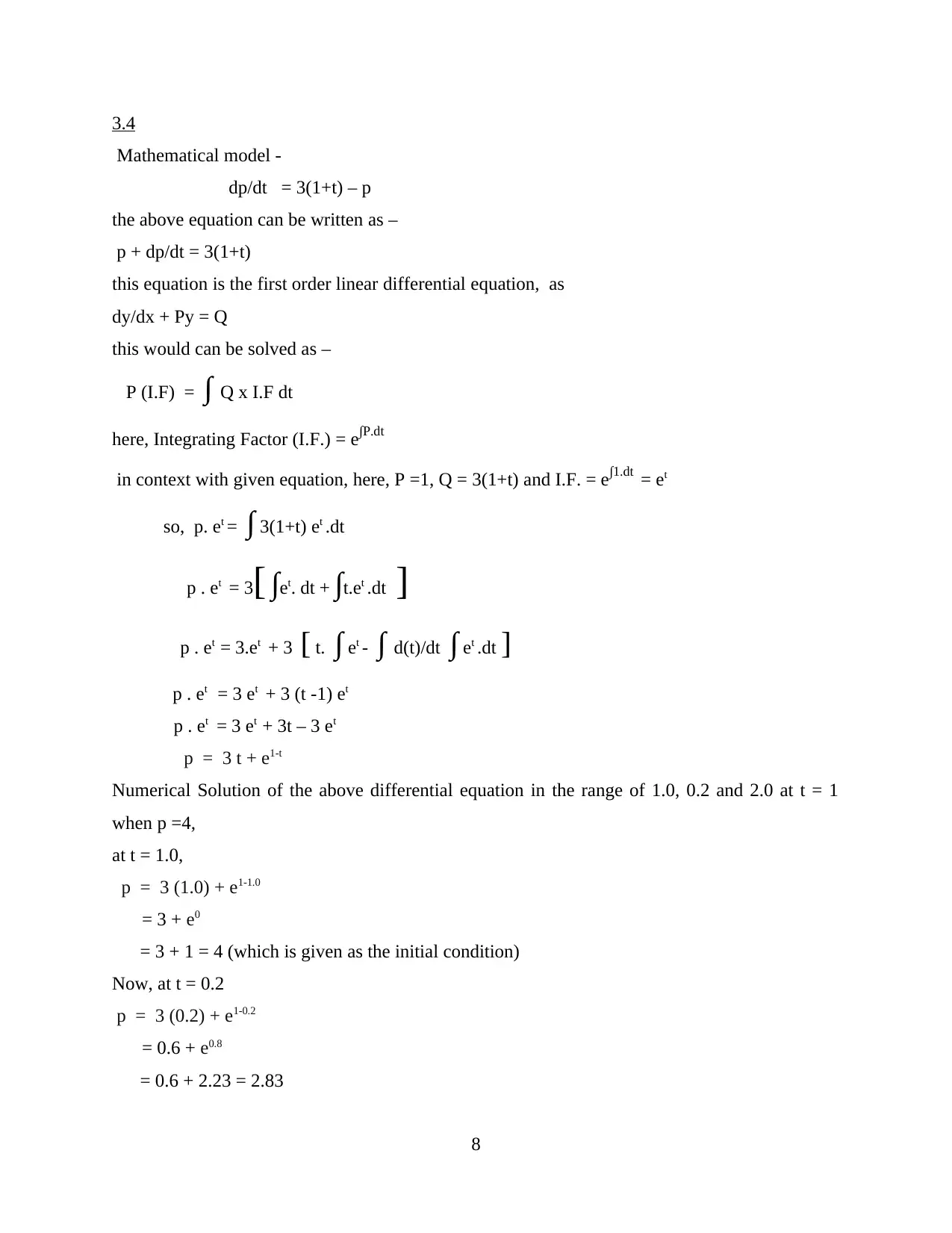
3.4
Mathematical model -
dp/dt = 3(1+t) – p
the above equation can be written as –
p + dp/dt = 3(1+t)
this equation is the first order linear differential equation, as
dy/dx + Py = Q
this would can be solved as –
P (I.F) = ∫ Q x I.F dt
here, Integrating Factor (I.F.) = e∫P.dt
in context with given equation, here, P =1, Q = 3(1+t) and I.F. = e∫1.dt = et
so, p. et = ∫ 3(1+t) et .dt
p . et = 3[ ∫et. dt + ∫t.et .dt ]
p . et = 3.et + 3 [ t. ∫ et - ∫ d(t)/dt ∫ et .dt ]
p . et = 3 et + 3 (t -1) et
p . et = 3 et + 3t – 3 et
p = 3 t + e1-t
Numerical Solution of the above differential equation in the range of 1.0, 0.2 and 2.0 at t = 1
when p =4,
at t = 1.0,
p = 3 (1.0) + e1-1.0
= 3 + e0
= 3 + 1 = 4 (which is given as the initial condition)
Now, at t = 0.2
p = 3 (0.2) + e1-0.2
= 0.6 + e0.8
= 0.6 + 2.23 = 2.83
8
Mathematical model -
dp/dt = 3(1+t) – p
the above equation can be written as –
p + dp/dt = 3(1+t)
this equation is the first order linear differential equation, as
dy/dx + Py = Q
this would can be solved as –
P (I.F) = ∫ Q x I.F dt
here, Integrating Factor (I.F.) = e∫P.dt
in context with given equation, here, P =1, Q = 3(1+t) and I.F. = e∫1.dt = et
so, p. et = ∫ 3(1+t) et .dt
p . et = 3[ ∫et. dt + ∫t.et .dt ]
p . et = 3.et + 3 [ t. ∫ et - ∫ d(t)/dt ∫ et .dt ]
p . et = 3 et + 3 (t -1) et
p . et = 3 et + 3t – 3 et
p = 3 t + e1-t
Numerical Solution of the above differential equation in the range of 1.0, 0.2 and 2.0 at t = 1
when p =4,
at t = 1.0,
p = 3 (1.0) + e1-1.0
= 3 + e0
= 3 + 1 = 4 (which is given as the initial condition)
Now, at t = 0.2
p = 3 (0.2) + e1-0.2
= 0.6 + e0.8
= 0.6 + 2.23 = 2.83
8
Paraphrase This Document
Need a fresh take? Get an instant paraphrase of this document with our AI Paraphraser
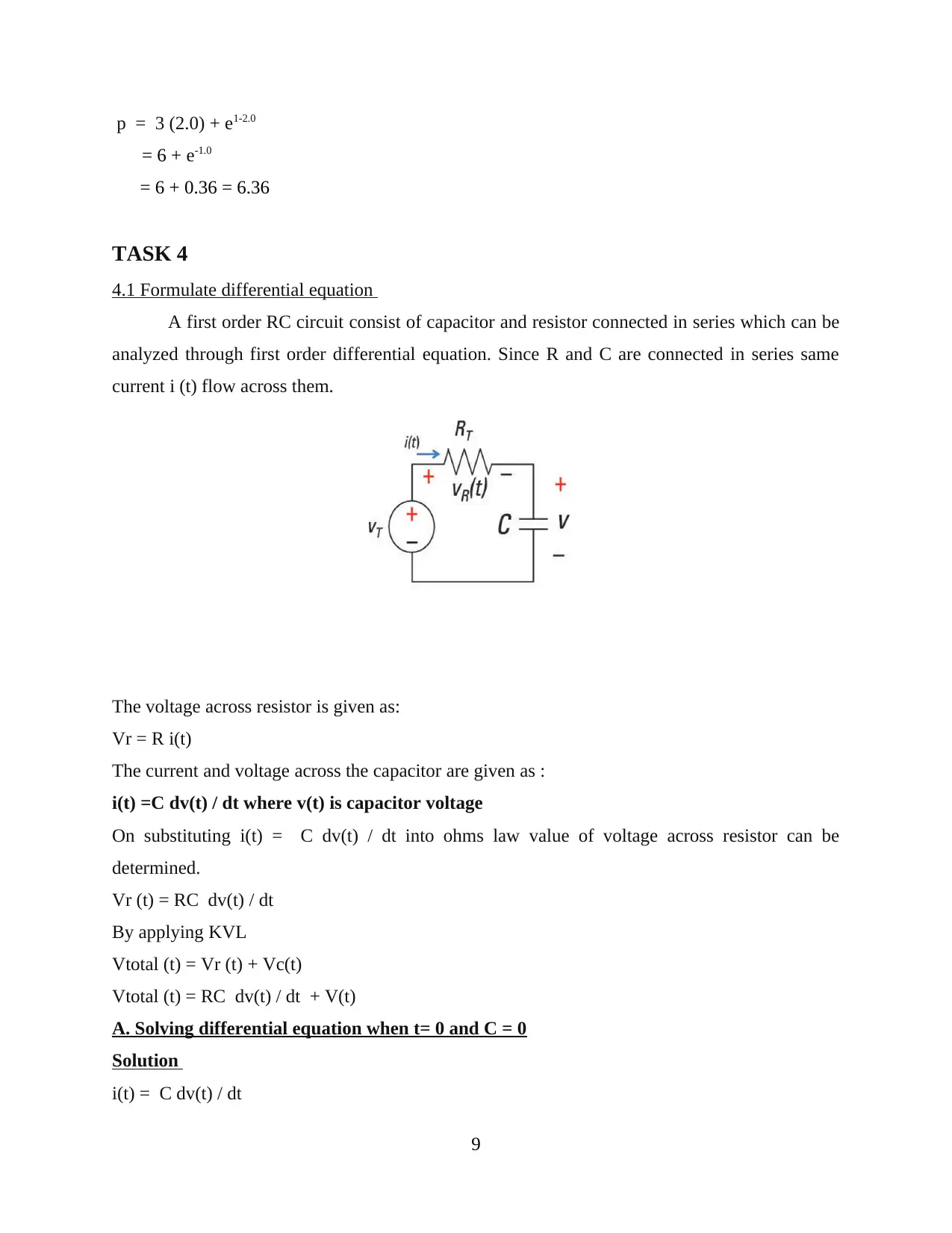
p = 3 (2.0) + e1-2.0
= 6 + e-1.0
= 6 + 0.36 = 6.36
TASK 4
4.1 Formulate differential equation
A first order RC circuit consist of capacitor and resistor connected in series which can be
analyzed through first order differential equation. Since R and C are connected in series same
current i (t) flow across them.
The voltage across resistor is given as:
Vr = R i(t)
The current and voltage across the capacitor are given as :
i(t) =C dv(t) / dt where v(t) is capacitor voltage
On substituting i(t) = C dv(t) / dt into ohms law value of voltage across resistor can be
determined.
Vr (t) = RC dv(t) / dt
By applying KVL
Vtotal (t) = Vr (t) + Vc(t)
Vtotal (t) = RC dv(t) / dt + V(t)
A. Solving differential equation when t= 0 and C = 0
Solution
i(t) = C dv(t) / dt
9
= 6 + e-1.0
= 6 + 0.36 = 6.36
TASK 4
4.1 Formulate differential equation
A first order RC circuit consist of capacitor and resistor connected in series which can be
analyzed through first order differential equation. Since R and C are connected in series same
current i (t) flow across them.
The voltage across resistor is given as:
Vr = R i(t)
The current and voltage across the capacitor are given as :
i(t) =C dv(t) / dt where v(t) is capacitor voltage
On substituting i(t) = C dv(t) / dt into ohms law value of voltage across resistor can be
determined.
Vr (t) = RC dv(t) / dt
By applying KVL
Vtotal (t) = Vr (t) + Vc(t)
Vtotal (t) = RC dv(t) / dt + V(t)
A. Solving differential equation when t= 0 and C = 0
Solution
i(t) = C dv(t) / dt
9
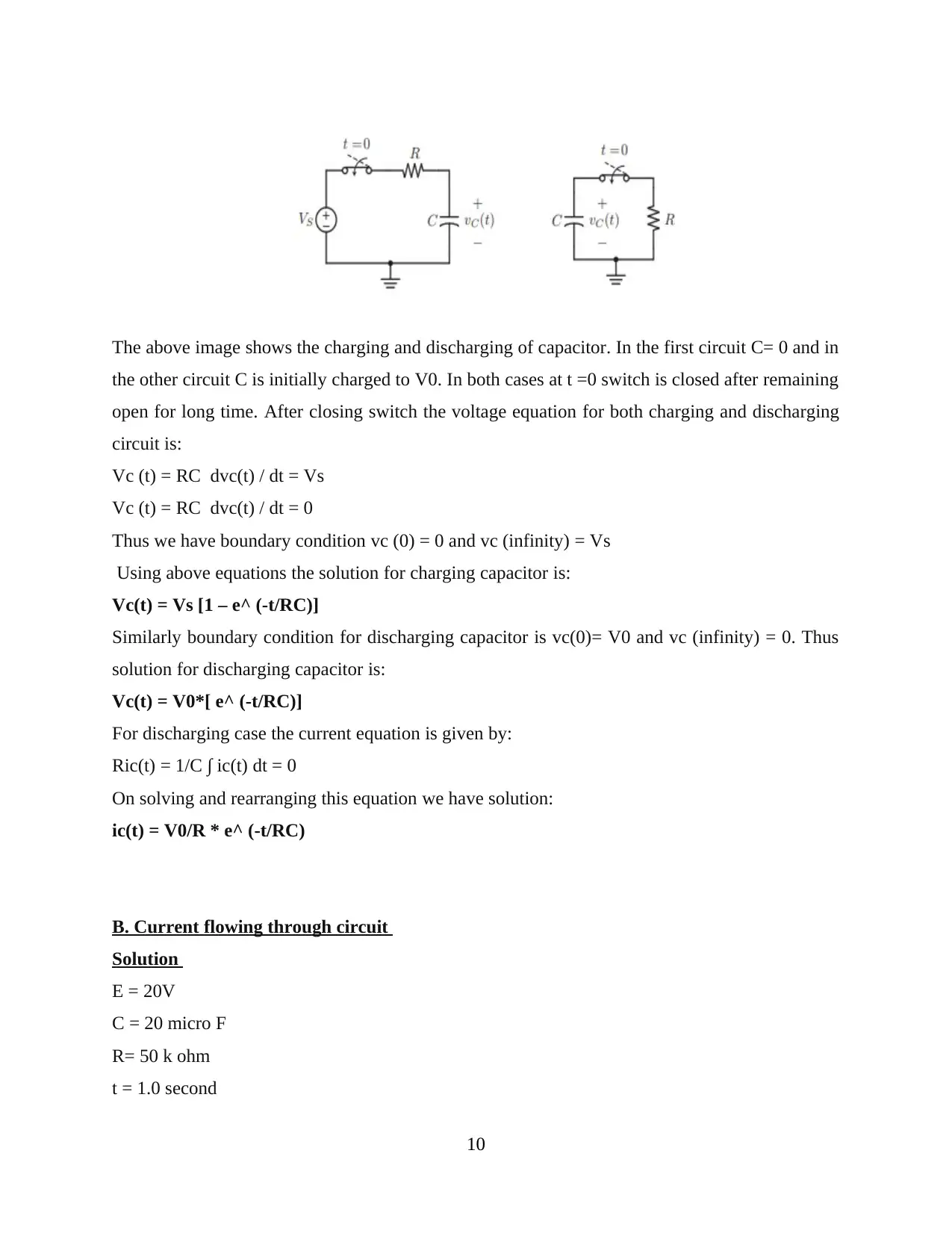
The above image shows the charging and discharging of capacitor. In the first circuit C= 0 and in
the other circuit C is initially charged to V0. In both cases at t =0 switch is closed after remaining
open for long time. After closing switch the voltage equation for both charging and discharging
circuit is:
Vc (t) = RC dvc(t) / dt = Vs
Vc (t) = RC dvc(t) / dt = 0
Thus we have boundary condition vc (0) = 0 and vc (infinity) = Vs
Using above equations the solution for charging capacitor is:
Vc(t) = Vs [1 – e^ (-t/RC)]
Similarly boundary condition for discharging capacitor is vc(0)= V0 and vc (infinity) = 0. Thus
solution for discharging capacitor is:
Vc(t) = V0*[ e^ (-t/RC)]
For discharging case the current equation is given by:
Ric(t) = 1/C ∫ ic(t) dt = 0
On solving and rearranging this equation we have solution:
ic(t) = V0/R * e^ (-t/RC)
B. Current flowing through circuit
Solution
E = 20V
C = 20 micro F
R= 50 k ohm
t = 1.0 second
10
the other circuit C is initially charged to V0. In both cases at t =0 switch is closed after remaining
open for long time. After closing switch the voltage equation for both charging and discharging
circuit is:
Vc (t) = RC dvc(t) / dt = Vs
Vc (t) = RC dvc(t) / dt = 0
Thus we have boundary condition vc (0) = 0 and vc (infinity) = Vs
Using above equations the solution for charging capacitor is:
Vc(t) = Vs [1 – e^ (-t/RC)]
Similarly boundary condition for discharging capacitor is vc(0)= V0 and vc (infinity) = 0. Thus
solution for discharging capacitor is:
Vc(t) = V0*[ e^ (-t/RC)]
For discharging case the current equation is given by:
Ric(t) = 1/C ∫ ic(t) dt = 0
On solving and rearranging this equation we have solution:
ic(t) = V0/R * e^ (-t/RC)
B. Current flowing through circuit
Solution
E = 20V
C = 20 micro F
R= 50 k ohm
t = 1.0 second
10
⊘ This is a preview!⊘
Do you want full access?
Subscribe today to unlock all pages.

Trusted by 1+ million students worldwide
1 out of 15
Related Documents
Your All-in-One AI-Powered Toolkit for Academic Success.
+13062052269
info@desklib.com
Available 24*7 on WhatsApp / Email
![[object Object]](/_next/static/media/star-bottom.7253800d.svg)
Unlock your academic potential
Copyright © 2020–2025 A2Z Services. All Rights Reserved. Developed and managed by ZUCOL.





